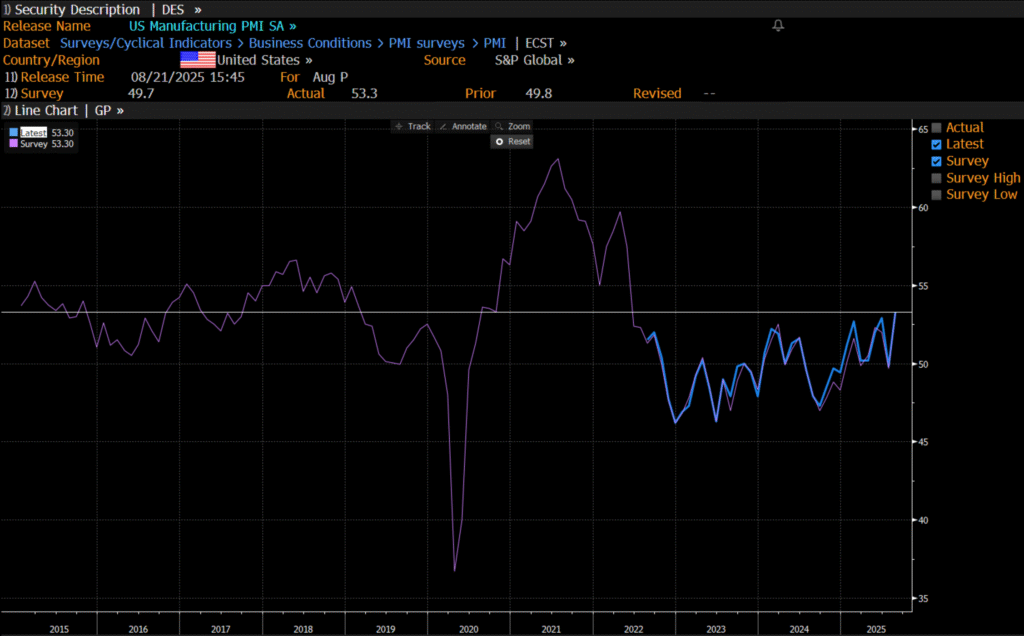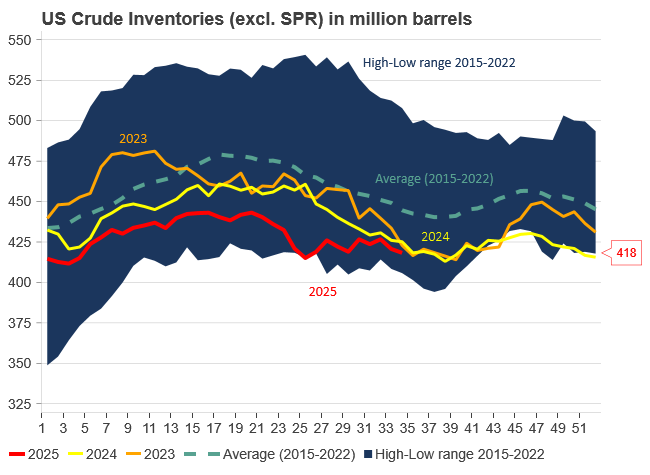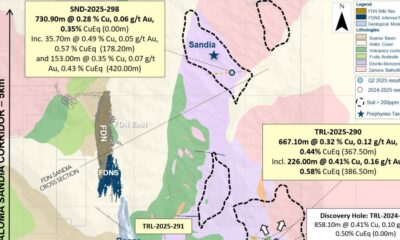Analys
SHB Råvarukommentar 10 februari 2016

International Petroleum Week i London
![]() Denna vecka var vi på International Petroleum Week i London, IP Week. Den årliga konferensen samlar oljehandlare från 50 länder för presentationer och diskussioner kring oljemarknaden. Kärnfrågan var som vanligt var oljepriset ska ta vägen och förväntningarna på Brent om ett år var lika delar över USD 45 som under. En mycket intressant kontrast till konsensus (med större andel aktieanalytiker bakom estimaten) där medianen fortfarande ligger på USD 55.
Denna vecka var vi på International Petroleum Week i London, IP Week. Den årliga konferensen samlar oljehandlare från 50 länder för presentationer och diskussioner kring oljemarknaden. Kärnfrågan var som vanligt var oljepriset ska ta vägen och förväntningarna på Brent om ett år var lika delar över USD 45 som under. En mycket intressant kontrast till konsensus (med större andel aktieanalytiker bakom estimaten) där medianen fortfarande ligger på USD 55.
Låga förväntningar
Diskussionerna kretsade kring oljemarknadens rebalansering, överproduktion, svag efterfrågan och effekterna av minskade investeringar i oljeindustrin. En sänkning av produktion från OPEC var fortfarande på agendan tillsammans med geopolitiska spänningar. Generellt har man flyttat ut tidpunkten för marknadsbalans till 2017 vid USD 25-30 och 2018 vid USD 40. Marknaden börjar således närma sig vårt senaste kontrarian-scenario med lägre priser 2017 än 2016, läs ”shale to fail” här.
OPEC
Av deltagarna trodde 24% på en cut från OPEC under året. Visserligen en minoritet men det förklarar de starka prisrörelser som uppstod vid spekulationer kring OPEC – och Ryssland sänkning tidigare i år. Saudiarabien har inte gjort ett enda uttalande i linje med en cut och ökade produktionen i januari. Det finns en ökad tro på en eventuell sänkning från OPEC längre fram när Iran återtagit sin export.
USA
Skifferoljans framtid diskuterades flitigt. Förväntansbilden på skifferproduktionen låg i ett smalt spann mellan 9,2 Mbpd (nuvarande nivå) till 8,7 Mbpd från de mest pessimistiska. Argus konstaterade att för att hålla USA:s produktion konstant krävs nu bara USD 40/bbl och för att skapa ny produktion motsvarande hela den globala tillväxten i efterfrågan räcker USD 67/bbl. Det scenariot kommer dock inte inträffa eftersom Iran, Irak och även Saudiarabien väntas öka produktionen och täcka upp för ökning i efterfrågan. Den som prognostiserar återhämtning till USD 70-80 måste således implicit inkludera en sänkning från OPEC.
USA får exportera råolja sedan årsskiftet men det var låga förväntningar (4%) på att det ska få någon inverkan på europeiska marknaden under 2016, om överhuvudtaget. De flesta verkade dock eniga om att WTI-priset bättre kommer spegla global balans och inte enbart amerikansk som fallet varit de senaste åren.
Iran
Irans ökade export var det hetaste samtalsämnet, 23% trodde att Iran kommer återta sin marknad i Europa redan detta år. Saudiarabien har dock gått ut hårt och sänkt priset till Europa för marsleverans. Flera påtalar också att Kinas handelmönster ”shop around” skulle tala för att mer av Irans olja kommer gå till Asien jämfört med före sanktionerna då 34% exporterades till EU och Turkiet. Allt talar för att konkurrensen om Asiens marginalköpare skruvas åt ytterligare ett varv under 2016 när ökad oljeexport från Nordamerika till Latinamerika konkurrerar med Nigerias och övriga Västafrika som då också måste söka sig mot Asien.
[box]SHB Råvarukommentar är producerat av Handelsbanken och publiceras i samarbete och med tillstånd på Råvarumarknaden.se[/box]
Ansvarsbegränsning
Detta material är producerat av Svenska Handelsbanken AB (publ) i fortsättningen kallad Handelsbanken. De som arbetar med innehållet är inte analytiker och materialet är inte oberoende investeringsanalys. Innehållet är uteslutande avsett för kunder i Sverige. Syftet är att ge en allmän information till Handelsbankens kunder och utgör inte ett personligt investeringsråd eller en personlig rekommendation. Informationen ska inte ensamt utgöra underlag för investeringsbeslut. Kunder bör inhämta råd från sina rådgivare och basera sina investeringsbeslut utifrån egen erfarenhet.
Informationen i materialet kan ändras och också avvika från de åsikter som uttrycks i oberoende investeringsanalyser från Handelsbanken. Informationen grundar sig på allmänt tillgänglig information och är hämtad från källor som bedöms som tillförlitliga, men riktigheten kan inte garanteras och informationen kan vara ofullständig eller nedkortad. Ingen del av förslaget får reproduceras eller distribueras till någon annan person utan att Handelsbanken dessförinnan lämnat sitt skriftliga medgivande. Handelsbanken ansvarar inte för att materialet används på ett sätt som strider mot förbudet mot vidarebefordran eller offentliggörs i strid med bankens regler.
Analys
OPEC+ in a process of retaking market share

Oil prices are likely to fall for a fourth straight year as OPEC+ unwinds cuts and retakes market share. We expect Brent crude to average USD 55/b in Q4/25 before OPEC+ steps in to stabilise the market into 2026. Surplus, stock building, oil prices are under pressure with OPEC+ calling the shots as to how rough it wants to play it. We see natural gas prices following parity with oil (except for seasonality) until LNG surplus arrives in late 2026/early 2027.

Oil market: Q4/25 and 2026 will be all about how OPEC+ chooses to play it
OPEC+ is in a process of unwinding voluntary cuts by a sub-group of the members and taking back market share. But the process looks set to be different from 2014-16, as the group doesn’t look likely to blindly lift production to take back market share. The group has stated very explicitly that it can just as well cut production as increase it ahead. While the oil price is unlikely to drop as violently and lasting as in 2014-16, it will likely fall further before the group steps in with fresh cuts to stabilise the price. We expect Brent to fall to USD 55/b in Q4/25 before the group steps in with fresh cuts at the end of the year.

Natural gas market: Winter risk ahead, yet LNG balance to loosen from 2026
The global gas market entered 2025 in a fragile state of balance. European reliance on LNG remains high, with Russian pipeline flows limited to Turkey and Russian LNG constrained by sanctions. Planned NCS maintenance in late summer could trim exports by up to 1.3 TWh/day, pressuring EU storage ahead of winter. Meanwhile, NE Asia accounts for more than 50% of global LNG demand, with China alone nearing a 20% share (~80 mt in 2024). US shale gas production has likely peaked after reaching 104.8 bcf/d, even as LNG export capacity expands rapidly, tightening the US balance. Global supply additions are limited until late 2026, when major US, Qatari and Canadian projects are due to start up. Until then, we expect TTF to average EUR 38/MWh through 2025, before easing as the new supply wave likely arrives in late 2026 and then in 2027.
Analys
Manufacturing PMIs ticking higher lends support to both copper and oil

Price action contained withing USD 2/b last week. Likely muted today as well with US closed. The Brent November contract is the new front-month contract as of today. It traded in a range of USD 66.37-68.49/b and closed the week up a mere 0.4% at USD 67.48/b. US oil inventory data didn’t make much of an impact on the Brent price last week as it is totally normal for US crude stocks to decline 2.4 mb/d this time of year as data showed. This morning Brent is up a meager 0.5% to USD 67.8/b. It is US Labor day today with US markets closed. Today’s price action is likely going to be muted due to that.

Improving manufacturing readings. China’s manufacturing PMI for August came in at 49.4 versus 49.3 for July. A marginal improvement. The total PMI index ticked up to 50.5 from 50.2 with non-manufacturing also helping it higher. The HCOB Eurozone manufacturing PMI was a disastrous 45.1 last December, but has since then been on a one-way street upwards to its current 50.5 for August. The S&P US manufacturing index jumped to 53.3 in August which was the highest since 2022 (US ISM manufacturing tomorrow). India manufacturing PMI rose further and to 59.3 for August which is the highest since at least 2022.
Are we in for global manufacturing expansion? Would help to explain copper at 10k and resilient oil. JPMorgan global manufacturing index for August is due tomorrow. It was 49.7 in July and has been below the 50-line since February. Looking at the above it looks like a good chance for moving into positive territory for global manufacturing. A copper price of USD 9935/ton, sniffing at the 10k line could be a reflection of that. An oil price holding up fairly well at close to USD 68/b despite the fact that oil balances for Q4-25 and 2026 looks bloated could be another reflection that global manufacturing may be accelerating.
US manufacturing PMI by S&P rose to 53.3 in August. It was published on 21 August, so not at all newly released. But the US ISM manufacturing PMI is due tomorrow and has the potential to follow suite with a strong manufacturing reading.

Analys
Crude stocks fall again – diesel tightness persists

U.S. commercial crude inventories posted another draw last week, falling by 2.4 million barrels to 418.3 million barrels, according to the latest DOE report. Inventories are now 6% below the five-year seasonal average, underlining a persistently tight supply picture as we move into the post-peak demand season.

While the draw was smaller than last week’s 6 million barrel decline, the trend remains consistent with seasonal patterns. Current inventories are still well below the 2015–2022 average of around 449 million barrels.
Gasoline inventories dropped by 1.2 million barrels and are now close to the five-year average. The breakdown showed a modest increase in finished gasoline offset by a decline in blending components – hinting at steady end-user demand.
Diesel inventories saw yet another sharp move, falling by 1.8 million barrels. Stocks are now 15% below the five-year average, pointing to sustained tightness in middle distillates. In fact, diesel remains the most undersupplied segment, with current inventory levels at the very low end of the historical range (see page 3 attached).
Total commercial petroleum inventories – including crude and products but excluding the SPR – fell by 4.4 million barrels on the week, bringing total inventories to approximately 1,259 million barrels. Despite rising refinery utilization at 94.6%, the broader inventory complex remains structurally tight.
On the demand side, the DOE’s ‘products supplied’ metric – a proxy for implied consumption – stayed strong. Total product demand averaged 21.2 million barrels per day over the last four weeks, up 2.5% YoY. Diesel and jet fuel were the standouts, up 7.7% and 1.7%, respectively, while gasoline demand softened slightly, down 1.1% YoY. The figures reflect a still-solid late-summer demand environment, particularly in industrial and freight-related sectors.


-

 Nyheter4 veckor sedan
Nyheter4 veckor sedanOmgående mångmiljardfiasko för Equinors satsning på Ørsted och vindkraft
-

 Nyheter2 veckor sedan
Nyheter2 veckor sedanMeta bygger ett AI-datacenter på 5 GW och 2,25 GW gaskraftverk
-

 Nyheter4 veckor sedan
Nyheter4 veckor sedanGuld stiger till över 3500 USD på osäkerhet i världen
-

 Analys4 veckor sedan
Analys4 veckor sedanWhat OPEC+ is doing, what it is saying and what we are hearing
-

 Nyheter2 veckor sedan
Nyheter2 veckor sedanAker BP gör ett av Norges största oljefynd på ett decennium, stärker resurserna i Yggdrasilområdet
-

 Nyheter4 veckor sedan
Nyheter4 veckor sedanLyten, tillverkare av litium-svavelbatterier, tar över Northvolts tillgångar i Sverige och Tyskland
-

 Analys3 veckor sedan
Analys3 veckor sedanBrent sideways on sanctions and peace talks
-

 Nyheter3 veckor sedan
Nyheter3 veckor sedanEtt samtal om koppar, kaffe och spannmål











